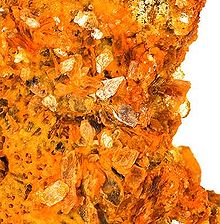- Copiapite
-
Copiapite 
Copiapite from the Bolesław Mine, Kłodzko District, Lower Silesia, PolandGeneral Category Sulfate minerals Chemical formula Fe2+Fe3+4(SO4)6(OH)2·20(H2O) Strunz classification 07.DB.35 Crystal symmetry Triclinic 1 Unit cell a = 7.337 Å, b = 18.76 Å, c = 7.379 Å; α = 91.47°, β = 102.18°, γ = 98.95°; Z = 4 Identification Color Sulfur-yellow to orange when crystalline, greenish-yellow to olive-green when massive Crystal habit Tabular pseudo-orthorhombic platy crystals, typically in scaly incrustations or granular pulverulent aggregates Crystal system Triclinic Pinacoidal Twinning Contact twins Cleavage Perfect on {010}, imperfect on {101} Fracture Irregular/uneven, micaceous Tenacity Fragile Mohs scale hardness 2.5 - 3 Luster Pearly on {010} Diaphaneity Transparent to translucent Specific gravity 2.04–2.17 Optical properties Biaxial (+) Refractive index nα = 1.506 - 1.540 nβ = 1.528 - 1.549 nγ = 1.575 - 1.600 Birefringence δ = 0.069 Pleochroism X = Y = pale yellow to colorless; Z = sulfur-yellow 2V angle Measured: 45° to 74°, Calculated: 48° to 72° Solubility Soluble in water References [1][2][3] Copiapite is a hydrated iron sulfate mineral with formula: Fe2+Fe3+4(SO4)6(OH)2·20(H2O).[1] Copiapite can also refer to a mineral group, the copiapite group.
Copiapite is strictly a secondary mineral forming from the weathering or oxidation of iron sulfide minerals or sulfide-rich coal. Its most common occurrence is as the end member mineral from the rapid oxidation of pyrite. It also occurs rarely with fumaroles. It occurs with melanterite, alunogen, fibroferrite, halotrichite, botryogen, butlerite and amarantite.[1] It is by far the most common mineral in the copiapite group.
 Lustrous, micaceous crystals of copiapite to 8 mm on matrix from the Alcaparrosa Mine, El Loa Province, Antofagasta Region, Chile (sample size: 11.9 x 7.4 x 4.0 cm)
Lustrous, micaceous crystals of copiapite to 8 mm on matrix from the Alcaparrosa Mine, El Loa Province, Antofagasta Region, Chile (sample size: 11.9 x 7.4 x 4.0 cm)
It rarely occurs as single crystals, is in the triclinic crystal system, and is pale to bright yellow. It is soluble in water, changing the water color to deep orange or orangish-red. In solution copiapite is very acidic. In high concentrations a negative pH can occur, as reported in waters draining from Richmond Mine at Iron Mountain, California.[2] Copiapite can easily be distinguished from native sulfur because it does not give off an odor when dissolved in water. It can be distinguished from similar appearing uranium minerals, such as carnotite, by its lack of radioactivity. The only way to differentiate between the minerals in the copiapite group is by X-ray diffraction.
Copiapite was first described in 1833 for an occurrence near Copiapó, Atacama, Chile.[3] It is sometimes known as yellow copperas. Other occurrences are in California, Nevada, and in the filled paleo sinkholes and caves of Missouri.
See also
References
This article about a specific sulfate mineral is a stub. You can help Wikipedia by expanding it.
